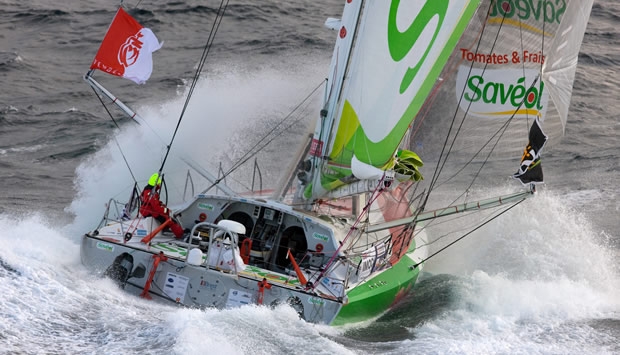
Sam Davies on the Vendee Globe
After she came home an impressive fourth in the 2008-9 Vendee Globe sailing a 2000 generation boat, there were high hopes for Britain’s Sam Davies in this year’s race, even though she was once again sailing an older generation boat. Sadly this was not to be when on 15 November, while negotiating a depression to the northwest of Madeira, the rotating wingmast rig on Saveol came crashing down.
At present Sam is still in the dark as to why the dismasting occurred. The wind was around 30 knots at the time but it was the wave conditions that were horrible thanks to the sudden change in wind direction due to her close proximity to the depression.
As she says: “I was sailing ever so carefully. It wasn’t because I had to much sail up. I couldn’t have taken any more care of my boat.”
Sam admits it took a while to pluck up the courage to go out on deck. While the tube fell sideways to leeward, taking out the stanchions on the way down, the bottom panel of the mast popped back upright (along with the bottom of the mainsail) thanks to the tension still on it from the halyards and other control lines.
“I was scared - half of the mainsail was still in the air in 30 knots of wind and there is no way I could get anywhere near it. With every wave, bits of mast were wanging around. But you don’t have a choice. I have always wondered how do people deal with it when their mast comes down. I remember a couple of my friends who did the Volvo saying to me 'when our rig came down there were 11 of us to deal with it...'”
The dismasting occurred at dusk and Sam initially planned to wait for daybreak to cut everything free. However of great concern was that the broken mast would compromise the watertight integrity of the hull and it wasn’t long before the winch on the mast began to chisel its way into Saveol's coachroof. She spoke to her shore team who had in turn been in contact with the boat’s original owner, Roland Jourdain, to find out he had dealt with it when the boat had previously dismasted. “Fortunately when the mast came down it missed the satcom antenna, so I still had comms. But it was hard to hear anything on the phone because the boom was smashing on the coachroof!”
As to the procedure to cut away the rig, Sam worked up a plan of attack with her shore team. She started off with the electronics cables going to the masthead, figuring she’d forget these otherwise. Then she eased off all of lines running into the pit area fortunately within easy reach of the safety of Saveol’s companionway.
Impressively in this age of carbon and aramid rigging she managed to dispose of the rig overboard solely with the use of a Stanley knife and without boltcroppers. Fortunately the carbon shrouds had effectively smashed on impact. Throughout she was careful not to leave herself exposed in a corner with anything likely to swing or fly towards her. “I gradually let things pivot around the boat. I released the foot of the mast, mast rotation lines, etc. I tried to save as much as I could. I should have saved the bottom part of the furling drums but I didn’t because the forestays were smashing up and down.” The toughest bits were the forestay and the bar tight deck spreader cables.
Whenever dismastings occur in the IMOCA 60 class one always thinks back to how Yves Parlier, who, in the depths of the Southern Ocean when his Aquitaine Innovations dismasted in the 2000 Vendee Globe, managed to get his rig (also a wingmast with deck spreaders) back on deck, repair it and then, perhaps hardest of all singlehanded, managed to restep it. “He is superhuman in my eyes,” admits Sam, in light of her experience.
In some ways she was lucky. “I shouldn’t complain. I would have much preferred to have carried on for longer, but when I dismasted I was 200 miles upwind of Madeira. And for a small budget I was quite pleased to be able to take my boat home myself. It wouldn’t have been the same story if it had happened in the Southern Ocean.”
She is also aware that typically the Vendee Globe sees a 50% attrition rate across the fleet (which it hasn’t reached so far in this race). “That is part of the adventure and the adrenalin - where am I going to end up? Am I going to make it all the way around? So I don’t take it for granted that I should still be out there.”
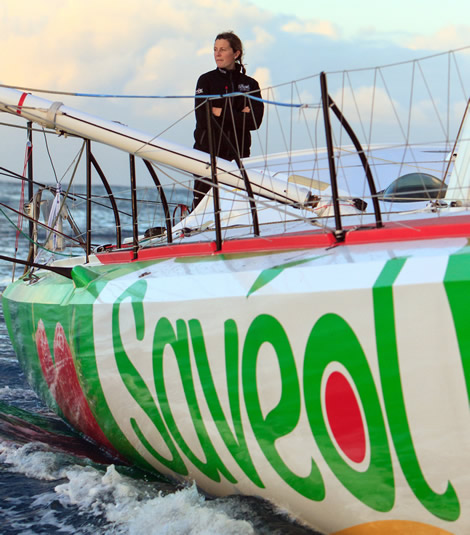
Some forensic work on why the rig came down is currently being carried out by Denis Glehens, whose company GSEA Design, designed and engineered the rig on Saveol, as they did for 12 of the 20 Vendee Globe starters. During the process of clearing the rig Sam wrote down where everything fell.
Although she was down below when the dismasting occurred and didn’t see how it fell overboard, Sam doesn’t believe the dismasting was due to a tube failure. “Tube compression failures typically make huge amounts of noise and this didn’t. And the shrouds are carbon rods - I am 100% sure that they broke on landing on the corner of the transom. We’ll see what the survey says...”
Personally the dismasting has taken its toll, not helped by being ill over Christmas. “It is tiring – you can’t wait for the race to start. Mentally the race is almost a rest because you don’t have to think about the preparation or your sponsors or sponsor sailing or the budget. You can just go and sail for three months and rest your brain. I was looking forward to those three months of rest.”
She has prematurely been thrust back into life ashore and all the demands of her campaign as well as having to look after her one and a half year old son.
While the dismasting was a profound set-back, her sponsor Saveol as well as the host of smaller co-sponsors backing her campaign are keen to press ahead for the 2016 Vendee Globe. In the shorter term Sam is waiting to hear whether they will stump up for a new mast that will allow her to go sailing this year.
“Saveol were happy. All their tomato growers seem to be happy. They replaced their TV advertising budget with my Vendee Globe and they have done some studies to see if it worked and it has come out the same, but with the television advertising their notority in terms of boosting the brand dropped really quickly. This seems to have better longevity.”
She is keen to do the next Vendee Globe in 2016-7, but once again says she wants to do it in a more competitive boat. “I don’t regret what I did, but it was completely knackering doing that in one year with so many sponsors and training and learning the boat, changing the keel and all the things we had to do. I am still completely shattered.”
Ideally she would like to start preparing for the next race this year with a new boat that is purpose-designed and built for her, as was the case with Kingfisher and Ellen MacArthur in 2000.
“Saveol are keen, but we need another bigger co-sponsor than the ones we have at the moment. I would love to find someone English. I miss not having an English sponsor. Maybe now the Olympics are over it will be easier - we’re talking to a few people. Then we can hit the green light. I have given myself until the end of this summer as a deadline. I want to do the Route du Rhum (in 2014) in the boat I’m going to do the next Vendee in.”
She intends to continue sailing her present boat this year. Even if it is slower than the present generation IMOCA 60s and frustrating to be sailing around at the back of the pack, there is still much to be learned. “I need to get better at manoeuvres and sail handling and sail trim – there are lots of things you can do with an older boat. I have to set my training plan, so that I can still progress and improve.”
Obviously she is still following the race and is not surprised to see the match race [okay, less of a match race right now...] between Francois Gabart and Armel le Cleac’h unfold at the front of the fleet. Prior to the start Sam was training with both of them in Port la Foret.
“From the training it was pretty obvious that they were very close in boat speed and they are the pretty much same the boat, built by the same people out of the same moulds with the same thought process. And they have the same approach – both Armel and Francois are similar, young guys coming from the Figaro circuit and the Port la Foret squad. They are not seasoned old dogs, although they have done it all their lives with the same background and training.”
She observes that Gabart, at 29 years old, is younger than Le Cleac’h who is 35 and has the experience of one Vendee Globe already under his belt, when be brought BritAir home in second place in the 2008-9 race. “Francois is younger and less experienced, but he is very very clever and he made up for that surrounding himself with MichDes and Mer Agitée. He’s spent a lot of time with Mich and got experience from him, learning about every little thing that might break and the problems that you have, etc. That’s the only thing he didn’t have compared to the others, but he’s had the nearest thing to having previous experience.”
Sam wonders whether Gabart and le Cleac’h, being so far ahead in the Southern Ocean, might not have come to some sort of gentlemen’s agreement not to press too hard, restarting their race proper once they were back in the Atlantic.
She also observes that they don’t appear to have suffered any downtime repairing their boats. This may have been due to both Gabart and le Cleac’h sailing a considerable number of miles in their respective boats prior to the start of the race and having the opportunity to iron out all the bugs. “In the last Vendee Globe the new boats were perhaps a bit too new. But with MACIF and Banque Populaire they have learned them, broken them and rebuilt them.”
This training has of course also helped their performance. While the skippers with plenty of hours on their boats know their settings (sails, ballast, stacking, both laterally and fore and aft, etc) well, Sam compares her own situation where she had less opportunity to sail her boat and would take longer to find the best trim configurations.
While we reckon that Banque Populaire and MACIF are special boats, VPLP-Verdier designs but with considerable input from two time Vendee Globe winner Michel Desjoyeaux and subsequently from both their teams (Banque Populaire in particularly one should remember has similar resources to a Volvo Ocean Race team), Sam believes they are no more special than the other new VPLP-Verdier boats including PRB and Virbac Paprec 3, all of which are close to being 'the perfect IMOCA 60'. “They are the dream IMOCA boats. I think Banque Populaire, MACIF and Virbac are the top three [PRB came off the same moulds as the older generation Safran]. With Virbac, J-P did work a bit on comfort and stacking and maybe he accepted a bit of a weight gain compared to the real Spartan approach on MACIF and Banque Populaire. And PRB is one of the teams that tried the hardest in terms of development work, pushing the limit, trying to get weight down.”
Sails may also be a contributing factor. While all IMOCA 60s are now obliged to have a fixed forestay under class rules, in the last Vendee Globe Michel Desjoyeaux’s race winning Foncia had a hook on all of the forestays and in place of his J2 he could fly a fractional Cuben fibre jibtop, something which you can’t easily do now because of the fixed forestay requirement. This sail would have seen considerable use beam and tight reaching outbound down the Atlantic and in the Southern Ocean, leaving the J2 relatively pristine (and allowing it to be more lightly built) for the more upwind conditions experienced sailing back up the Atlantic on the run home.
Sam reckons that both Banque Populaire and MACIF will have found a way to do something similar, while on Saveol, because she didn’t have a fractional halyard or a hook her reacher replaced her J1 and for budgetry reasons wasn’t made of Cuben fibre.
As to Alex Thomson’s performance in the Vendee Globe, Sam takes her hat off to him. “He is doing a proper Vendee Globe. He’s sorted out his power problems himself and is taking care of his boat. He has changed.”
However she isn’t overly optimistic about Hugo Boss’ current position tackling the trough to the south of Rio. “The transition zone - that is what Marc [Guillemot] and I had to deal with [in the last Vendee Globe]. I haven’t studied it closely, but it looks the same and unfortunately it tends to move with you, so your weather routing gets you across much faster than you actually do. But he is doing really well and the upside is that being west makes for an easier passage through the Doldrums.”
Fingers crossed that Sam can get her campaign back on the road, for she remains one of the UK’s most talented solo sailors and one of our best hopes for doing what Ellen MacArthur didn’t quite manage – becoming the first British sailor to win the Vendee Globe.

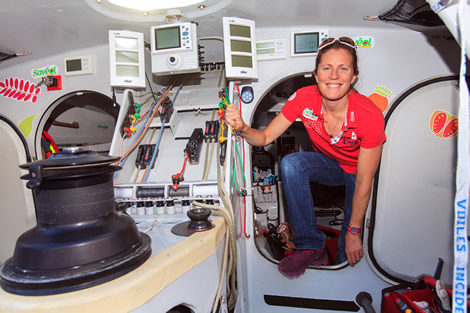
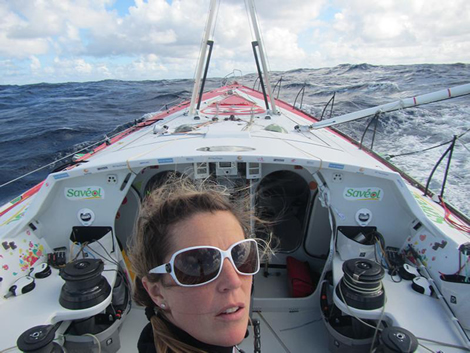
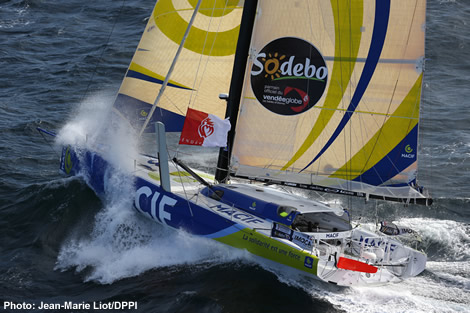
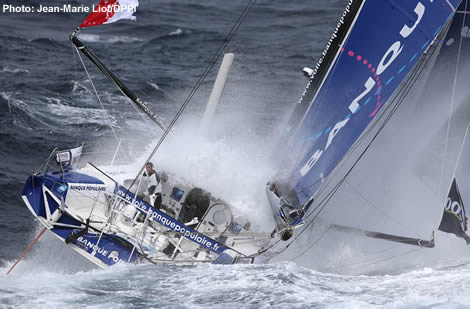









Latest Comments
Add a comment - Members log in